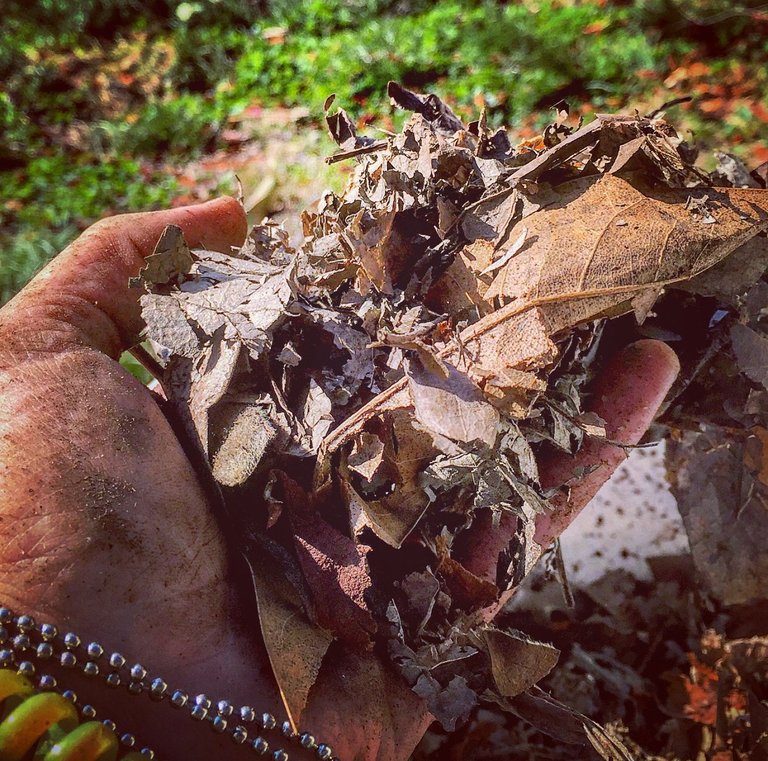
I’ve been posting recently on my DIY urban composting experiment in a city which does not allow me to have traditional compost piles or bins...so I made my own composter/digester out of two five-gallon buckets that I acquired for free, and you can read about that here and how to make your own, as well.
After dealing with crazy Missouri weather, I also posted about the journey of moving the compost from outside (which was the plan) to inside (because it got cold af outside).
A (timely) Revelation
The Scientist knows about this stuff a lot more innately than I do...or maybe she just has years more studying under her belt and real botany classes in college...but something I didn’t even think about having the compost inside:
...drum roll please
THE POSSIBILITY OF MOLD SPORES GETTING CLOSE TO MY MICROBABIES!
[Remember when I said I moved the compost inside next to where I keep my micros?] Well, even though that sounded like a good idea, I realized that while things don’t look moldy and nasty in there (super healthy, actually), that my (very sensitive) allergy to spores in the air became apparent, and I realized that while I might store the buckets inside, I’m definitely not going to want to store it next to the plants. I’m actually going to wear a protective facial mask 😷 when I stir this bad boy up from now on...as you’ll see fashionably modeled by me in photos below. Bahaha.

As an experiment, for the past couple of days (I’ve only been stirring every 48 hours...), I actually went ahead (out of paranoia from contaminating a fuckload of new microgreens I had set out) and moved the composter outside. The weather has been cold at night and not that warm during the day, so for as far as “Midwest-regular” temperatures, as I’m writing this (before I go out and stir this thing up), my questions are related to...obviously, the heat that is hopefully continuing to be created within the mix. Also, it has rained a little bit so I know the mix will be more more moist than it was last time I visited it, so I will be interested in what I see when I “pop the top” on the digester and see where we are in the composting process.
I’ve been gong though a bit more paper towels than usual (does anyone know if they work well in compost)?, and one of the best “browns” that are able to fulfill that 3:1 green-to-brown material ratio, so I’ve been spending a lot of time ripping up paper towel rolls. Hoping to eliminate that completely soon. We went with roll-less toilet paper a while back and haven’t been disappointed.
Okay, I’m going to do the work now, document and be right back!
...waiting
...waiting
...wating
The Results!
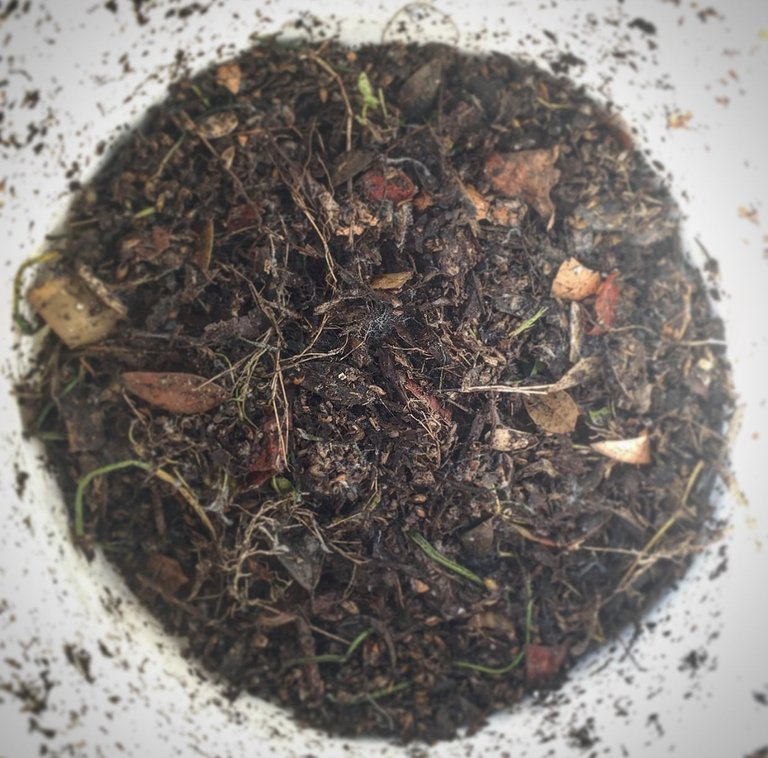
This looked pretty good, although I could tell the heat that was being generated inside was not being generated outside. While I could definitely tell decay was happening and could pick out humus being created in the mix. Very exciting. I attempted again to stir with a stick, but decided (once more) that getting in there with your hands is the best method. Just take off your rings and if you have a fabric-based watch band of any variety—be prepared to replace that quickly or take it off before digging it.
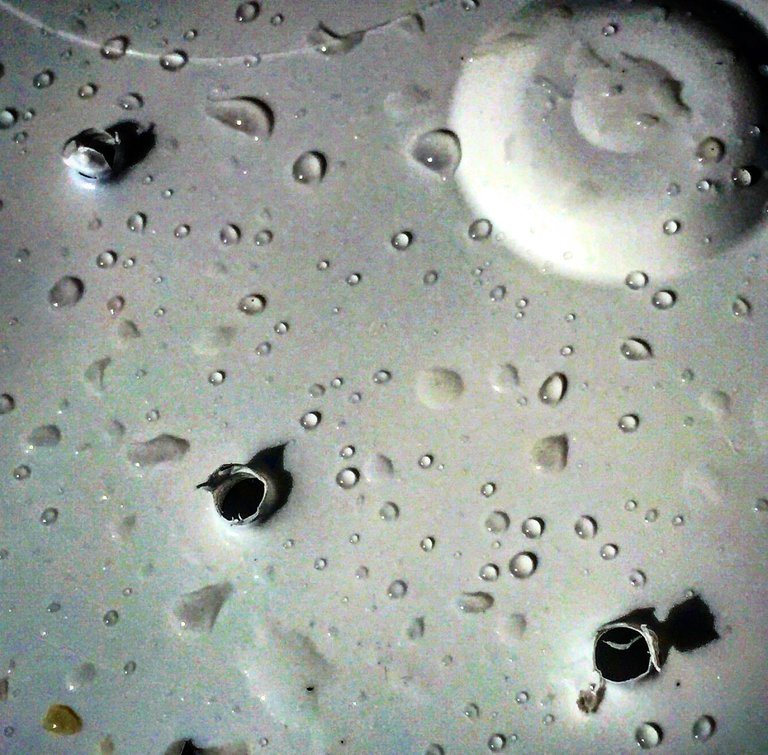
I also noticed that the top lid did contain condensation, so this is also a plus.
I went ahead and first laid down a layer of the dry, torn up paper towel roll into the basic mix before I mixed and subsequently added more brown material.
This was after the first good turn. I’ve noticed about the rumors of rinds (like from my delicious spaghetti squash, and onion skins take a bit longer to compost, this is true. I have been making effort to break down the pieces every time I turn the compost, and I do notice they’re holding heat, so I know they’re breaking down, however taking a bit longer.
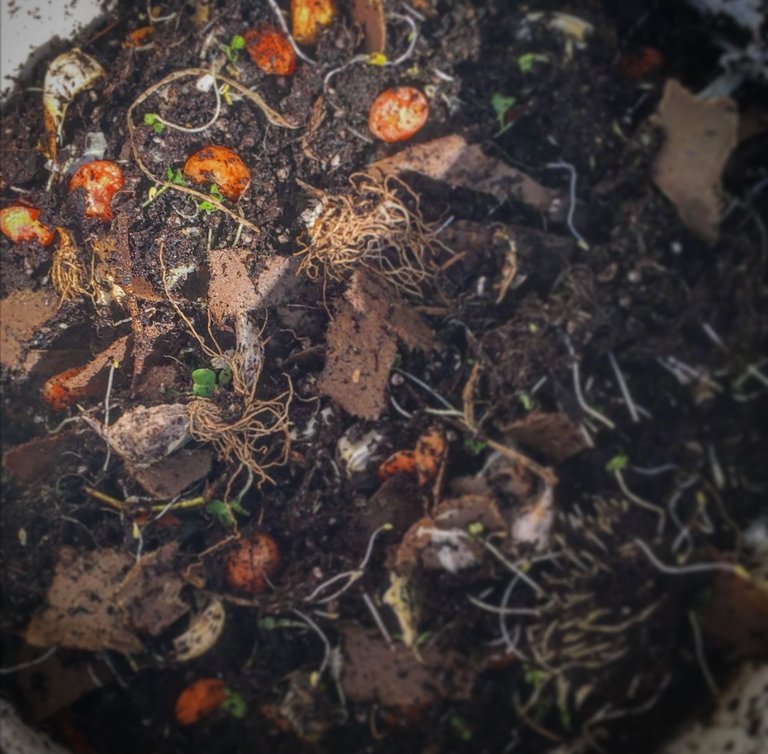
I had collected a full bunch of goodies to add to the compost bucket, so I was excited to get that going. In this bunch are soil bunches with roots from microgreens, carrots, and some tomatoes that had slipped out into the sink drain before I could save them..along with our regular regimen of regularly adding coffee grounds as well.
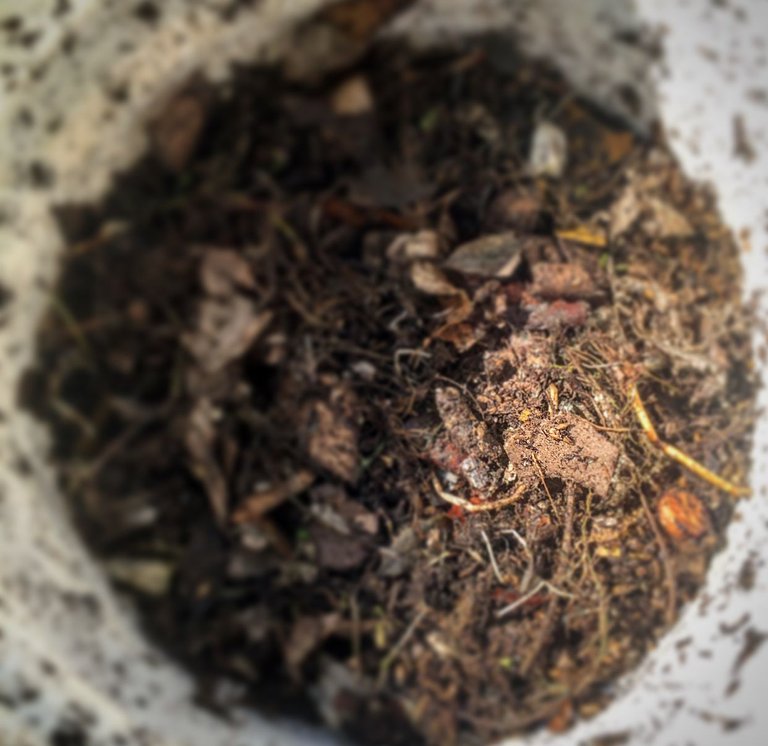
In maintaining that important 3:1 ratio of “brown” (carbon), and “green” (nitrogen) delivering organic products, I make sure to break up leaves really well from a pile that The Scientist has constructed for me. I have nice access to wetter, breaking down leaves in the pile, as well as leaves that are nice and dry and easy to crush up to add a nice mix into my slightly wetter-than necessary bucket.
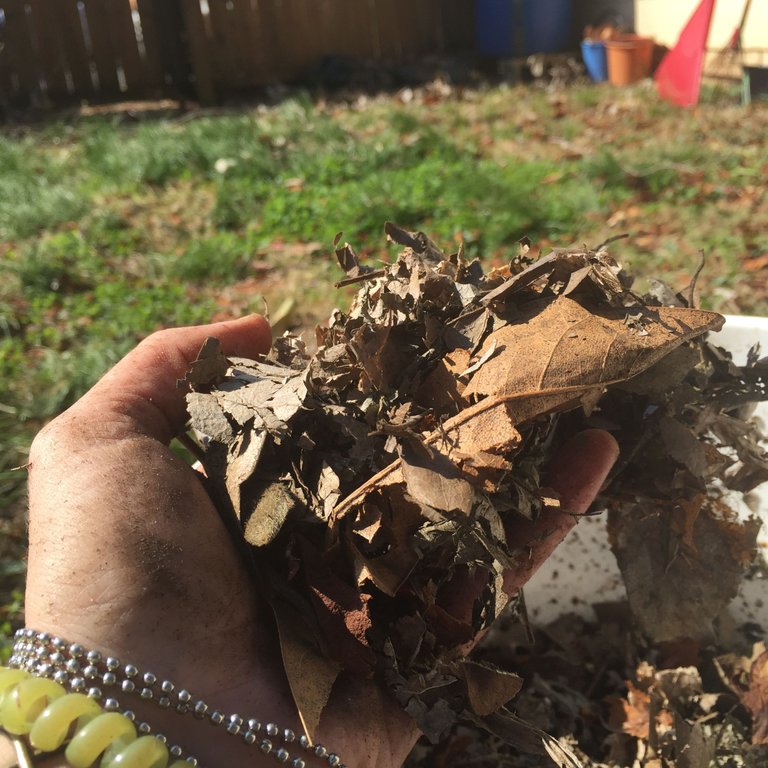
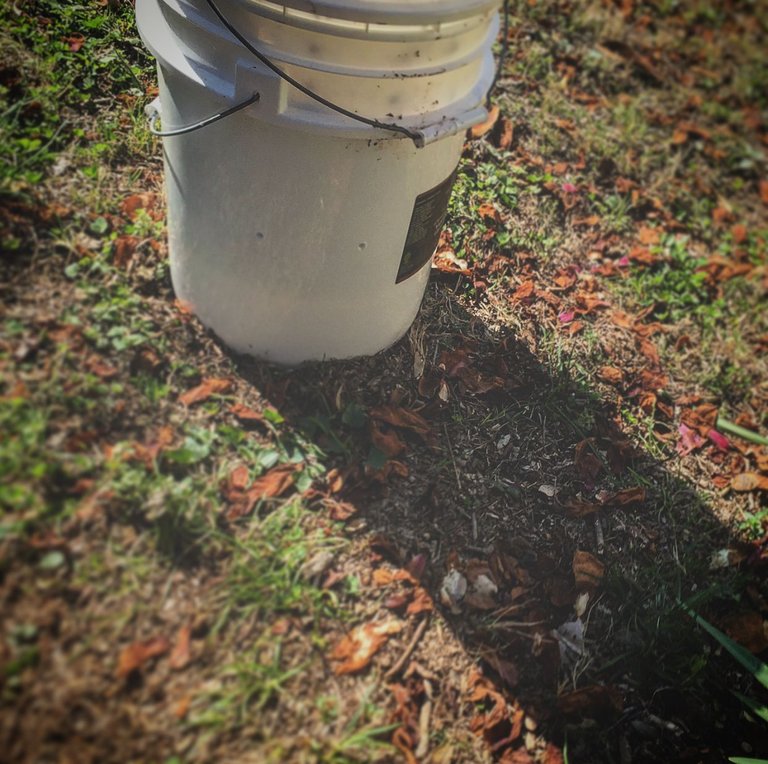
Here’s what it looks like now, right after I closed it back up and sat it in the sun (new experiment since it’s relatively nice outside), so I’m hoping the temperature picks back up inside the bucket and the digesting gets rocking and rolling full-speed again.
Would love to hear your urban composting tips, tricks and methods!
Thank you for taking the time to check out my blog, and I hope you find it helpful!

COMMUNITY IS THE NEW MONEY

Community Forums








DISCLAIMER: dropahead Curation Team does not necessarily share opinions expressed in this article, but find author's effort and/or contribution deserves better reward and visibility.
to maximize your curation rewards!
with SteemConnect
12.5SP, 25SP, 50SP, 100SP, 250SP, 500SP, 1000SPDonate STEEM POWER to @dropahead
Do the above and we'll have more STEEM POWER to give YOU bigger rewards next time!
News from dropahead: How to give back to the dropahead Project in 15 seconds or less
Quality review from the dropahead Curation Team
According to our quality standards(1), your publication has reached an score of 83%.
Keep trying, you will soon achieve excellence!
(1) dropahead Witness' quality standards:
-Quality, technique and aesthetics of photography (Good framing, good focus, sufficient brightness, adjusted to what the photograph intends to express.)
-Adaptation and relationship with the general theme raised (clearly reflects the proposed theme)
-Capacity of the composition (causes sensations, emotions)
Looks like you're getting your hands dirty and that's always fun! ;) Davis has built us a compost box that is by the new garden spot, so we've been monitoring what we put in there. I'm not clear on the whole process but he seems to know what he's doing! Haha!
As long as you keep turning it, it kinda does it’s own thing. Boxes and piles are the best way, imo, we always had an active compost pile back when I was growing up. My dad is the master composter.
woow it's a very creative idea, whether it can be used for pamelo fertilizer, I happen to be a pamelo tree farmer...
What are the specific carbon/nitrogen/potash requirements for a pamelo compost/fertilizer?
This method also makes a great compost tea collector in the bottom which can also be applied around the roots of plants for an added amount of nutrients into the soil water itself. That may be an option, too.
However, this method should work for just about anything as long as you keep specifically your carbon and nitrogen (green to brown) ratios appropriate for the plants you use them with.
Best of luck, and thanks for your kind words!
Regarding specific carbon / nitrogen / potas requirements for compost pamelo / fertilizer?
To accelerate the growth and fruit pamelo more and more.
Usually here we use cow dung that has become soil, or manure
Yes, but do you know your ratios of each of those for the optimum accent ration of growth? That’s a huge key in the compost game. Knowing your audience. Lol your plant audience.
Good compost skills!!! Why is it you arent permitted to make it outside? Thats crazy!
My municipality has a lot of ridiculous laws about sustainable practices. I think it’s because one of our longest standing representatives gets so much money from big pharmaceutical and Monsanto.
That is REALLY awful..the people need to kick him out!!! I hear about that kinda thing over there but can never quite believe it.
Congratulations! This post has been added to our growing directory of Steemit "how to" posts, upvoted and resteemed. Sotall curates posts for the Homesteading/Survival/Foraging/Prepper communities. If you haven't done so already, you can claim your badge along with the code to add to your posts to let the world know you have chosen to help others Survive, Thrive and be Prepared! Click here to get the code
I tried using a 5 gallon bucket for compost on my balcony once and it molded. I figured it was too wet from all my coffee grinds (I was dumping them in wet from a French press), but also I just had the one bucket - are you putting one bucket inside another with drain holes? I haven't tried again since.
Check out this DIY bucket build method I posted about a few days ago, and make sure you are stirring it regularly to aerate it. With the small buckets, mold is a big factor that the stirring and the aforementioned bucket build should help deter. Also, if you are adding a lot of wet items, a bit of sawdust or dried leaves can help balance that humidity out.
Try it again and let me know how it goes!!
Alright, I will try this! :) Thanks for the tutorials!
Nice photos. they deserve an award. It is very nice. great work
@AbuseReports @Duplibot @Spaminator @SteemCleaners @SteemFlagRewards @Steemit-Abuse
Comment Spam